Package contains: 1 x FIBREX PP+GF30 POLYPROPYLENE - Black / 1.75mm / 500g - 3DXTech
FibreX? PP+GF30 is made using a specially formulated 30% glass fiber reinforced polypropylene copolymer created specifically for 3D printing. The formulation offers improved thermal properties and less contraction and deformation than competitive PP-based compounds.
Strengthening this trusted engineering polymer with glass fiber has truly made it a game changer for industrial applications. 3D printed PP+GF30 parts can be found in a wide range of real-world functional end uses or prototypes with automobiles, tooling and jigs, home appliances and sporting goods.
Advantages of PP+GF include:
Excellent resistance against a huge variety of chemicals
Low density and weight
Low shrinkage and warpage
Does not absorb moisture, no drying required!
High strength, stiffness and impact resistance
Chemical Resistance of PP+GF
Because properties can change depending on the printing environment and the geometry and/or surface of the 3D model, you should always perform your own tests, but polypropylene is known for its chemical resistances to a wide range of environments, including:
Acids: Acetic, Boric, Hydrochloric, Phosphoric, Stearic, Sulfuric, Uric
Bases: Ammonium, Barium, Calcium, Magnesium, Potassium, Sodium hydrocides
Solvents: Acetone, Ethanol, MEK, Phenol (10%), Water
Filament specifications:
Diameter: 1.75 mm (+/- 0.05 mm)
Recommended print settings:
Extruder: 240-270°C
Platen temperature: 80-110°C
Nozzle: we strongly recommend a hardened steel nozzle with a minimum diameter of 0.4 mm for abrasive materials such as this
Other: the ideal layer height is 60% of the nozzle diameter. We do not recommend printing layers smaller than 0.2 mm with abrasive filaments
Platen preparation: we recommend the use of an adhesive or poly tape
Heated chamber: not necessary
Media: AquaTek? Water Soluble X1 USM Universal Support Material is one of the few materials that can properly form a strong, temporary bond to the support. Polypropylene is notorious for being difficult to support and X1 USM is ideal for the job
Drying Instructions: not required
Abrasive Material
This material is particularly abrasive among 3D printing filaments. Users may find that standard brass nozzles are chewed up very quickly compared to standard wear. If worn, the nozzle diameter will expand inconsistently and the printer will encounter extrusion problems.
For this reason, we strongly recommend printing this material through a hardened steel nozzle rather than a softer metal. Hardened steel nozzles can often be inexpensive and easy to install depending on the printer manufacturer's instructions.












